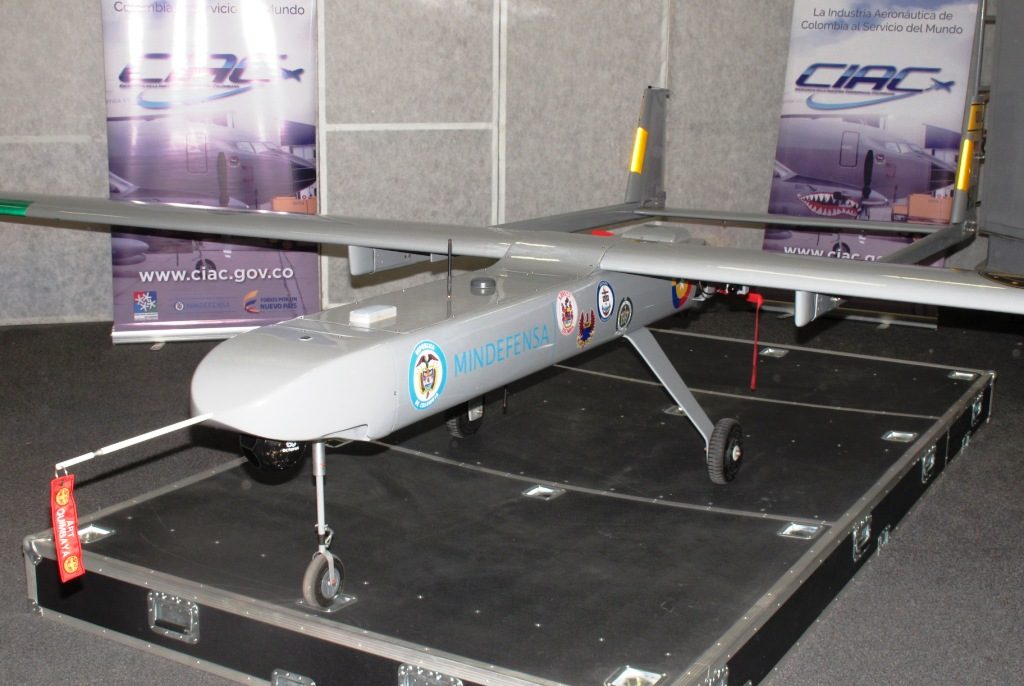
A joint audience for the Quimbaya UAV system
By Paolo Valpolini, David Oliver and Douglas Hernandez
The thrust to become as independent as possible in terms of defence acquisitions led the Colombian Ministry of Defence to launch the development of a fully national tactical UAV system, which has been officially presented during Expodefensa 2019. On Day 2 of Expodefensa a contract was signed between the Ministry of Defence and CIAC for the supply of one Quimbaya unmanned aerial system, comprising three air vehicles and a ground control station for the National Police. It has always been made clear that the military-developed UAV would have then be shifted for production to the Corporación de la Industria Aeronáutica Colombiana, CIAC in short, which is anyway part of the Ministry of Defence.

The programme has been developed by a team of 10 military engineers of the various services, with a full joint approach, the initial team was made of three aviation engineers, now reduced to two, two mechanical engineers and five electronic engineers, led by an Air Force officer. Some of those are also ScanEagle pilots with considerable experience, that brought in the team the lessons learned during their operational life.
The Quimbaya architecture is quite classic, with the forward fuselage hosting all key electronic elements as well as the fuel, the engine being at the rear of the fuselage, fitted with a two-blade propeller; the structure is mostly made of carbon fibre to optimise the strength/weight ratio. The UAV is powered by a Hirth Motors 4103 8.2 hp two-stroke engine; this generated some headaches to the team, as in the two flights carried out until now it stopped after a short time while all parameters were fully under control. This is slowing down the flight test programme, the engine having been sent back to Germany for a thorough check. The twin-boom tail is also typical of pushing propeller UAVs, a tricycle high landing gear allowing maximum ground clearance to the payload. A 360° camera system allows the pilot to check what goes on around the aircraft during the turn around.

The Quimbaya has a 5.24 meters wingspan and a length of 4.11 meters, maximum take-off weight being 70 kg, 12 kg being the payload that includes a 2.6 kg Epsilon 175 electro-optic sensor designed and built by UAV Factory in Latvia, and other systems. Operating ceiling is 3,600 meters, endurance being of 8-10 hours, the range being 100 km ± 10 km in line of sight, a further 20 km being added when operating beyond line of sight, the last part of the flight being pre-planned while imagery would be recorder on board and downloaded at a later time. The current fuel tank has a capacity of 15 litres, however according to the military engineers who designed the aircraft there is still room for more fuel, the system being modular this might allow to increase range while flying with a reduced sensors payload suite.
The first flight took place in June 2019, and was followed by a second, and then the aforementioned problems prevented the team from continuing the activity. Both flights were carried out with manual take-off and landing, the team being now busy in fine-tuning the automatic take-off and landing system that should be tested as soon flight tests will be resumed, possibly in March-April 2020.
Among key elements available in the Quimbaya that are not in the ScanEagle, the team engineers mentioned the transponder, to allow flight in controlled airspace, a beacon to find the aircraft in case of emergency landing, and the capacity to restart the engine in flight, should it stop for some reasons.
The aircraft can be easily disassembled, a specially designed container hosting the fuselage in the centre, the tail around it and the wings on the sides. This container, as well as the Ground Control Station shelter, have been designed to be easily transported inside a C-130 Hercules, for rapidly deploying the system at long distances.

Coming to the GCS, two main consoles are available for the pilot and the intelligence operator, the mission commander post being on the opposite wall and being made of a laptop computer. The GCS hardware respects the MIL STD 1472, which establishes general human engineering design criteria for military systems, while software was developed to ensure maximum similarity to that of the ScanEagle, in terms of commands, colour code and workflow, in order to facilitate the transition from one system to the other. Crew shifts will last four hours, as in the ScanEagle. As for pilot’s selection, in the past these were taken from the flight line, one of the development engineers having flown the Tucano, however the Fuerza Aérea Colombiana is now changing its approach, engineers receiving an adequate training to become UAV pilots.

The Quimbaya will be operated by the Air Force, this service having also been the one that drafted the requirements, such as operating ceiling and wingspan, during the development phase, however the system will be available to all services for operations and training, integrating it in the available ISTAR assets of the Army, Navy and Police, and in their C2 systems.
So far the development of this project has demanded about 5 million dollars. The programme was co-financed by Ecopetrol, the state oil company of Colombia, and therefore one of its missions will be to monitor the country network of pipelines and gas-duct. The Quimbaya estimated price is between 2.5 and 3.5 million dollars.
The National Colombian Navy is looking for a smaller UAV, in the 20-30 kg MTOW range; this project should be launched at medium term, however to date it is unclear if the experience acquired by the joint team will be exploited, or if the Navy will develop it on its own.
Photos by Paolo Valpolini and David Oliver



